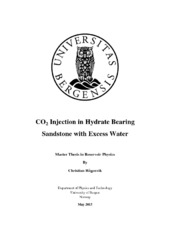| dc.description.abstract | It has previously been shown that methane can be produced from gas hydrates by exposing it to carbon dioxide. Since CO2 is the preferred hydrate former below 10 °C it will spontaneously replace CH4 as the guest molecule in the hydrate without introducing heat. This production method is beneficial because it offers long term storage of CO2 with the added benefit of produced methane without dissociating the hydrate. Previous experimental research on production from gas hydrates by CO2 injection has been conducted in cores featuring relatively small amounts of free water. In nature, gas hydrates generally exist in the presence of excess water. The main objective of this thesis is to investigate how the presence of excess water will affect CO2 injection in hydrate bearing sediments. Ten experiments were conducted at the hydrate lab at the Department of Physics and Technology at the University of Bergen. Methane hydrate was successfully formed in Bentheim sandstone cores at various initial conditions. The experiments were conducted at gradually increasing initial water saturation in order to achieve water in excess, resulting in final water saturations up to 50 %. It was found that the residual water saturation after hydrate formation increased with initial water saturation. This might be a result of water saturating a larger fraction of the pores and thereby inhibits gas flow in certain regions, both microscopically and macroscopically. In the experiments with low initial water saturation, the hydrate formation seemed to be constrained by water availability and salinity. After hydrate formation was completed, CO2 injection was conducted. It was discovered that the injection of CO2 in hydrate bearing sandstone with excess water could lead to additional hydrate formation, resulting in loss of injectivity and plugging of the core. This problem was successfully met by injecting a binary mixture of N2 and CO2. It was discovered that nitrogen inhibited additional hydrate formation and also increased the total methane recovery and CO2 storage potential by dissociating a fraction of the methane hydrate. It was also found that nitrogen could be used to re-establish flow in a plugged core. CO2 sequestration was observed by several different methods. It was found that the injection of CO2 in hydrate bearing sandstone could result in CO2 sequestration either by the formation of additional hydrate with the excess water or by replacing CH4 as a guest molecule. The implementation of a mass flow meter improved the quantitative production calculations compared to previous experiments. | en_US |
